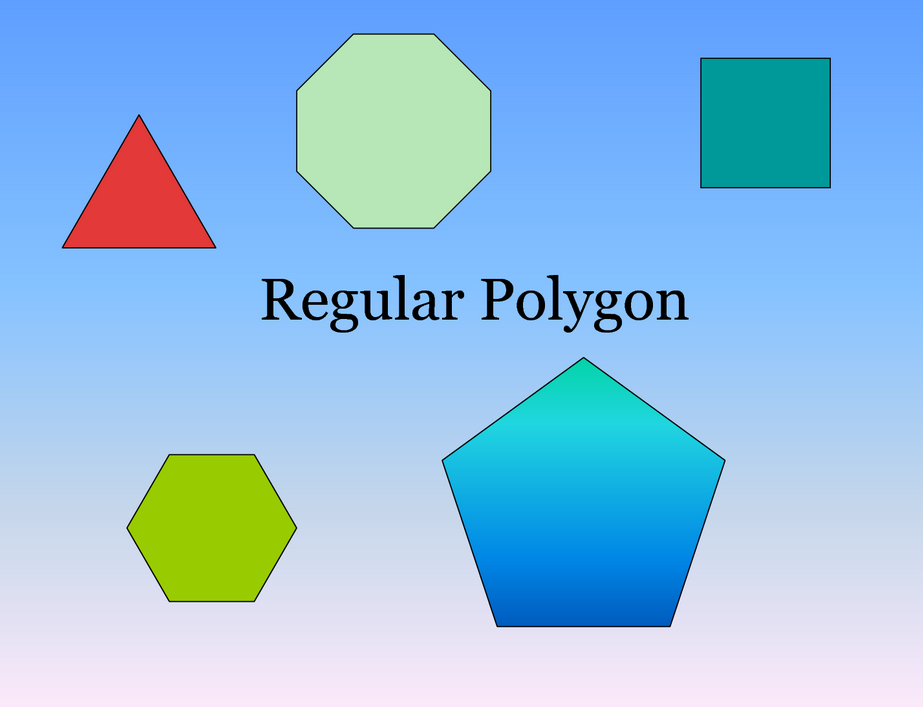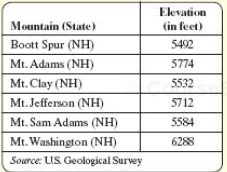Perimeter of Polygons: Before we address this topic we need to define the two terms Perimeter and Polygon: The perimeter is the distance around the outside edge of a shape. A polygon is simply a shape as described below.
A POLYGON is a closed TWO DIMENSIONAL figure bounded by three OR MORE line segments.
You will notice that the BLUE figures are all polygons. They are flat (two dimensional figures) that are CLOSED (the black line segments completely enclose the blue interior).
There are THREE things that prevent the PINK figures from being considered POLYGONS
1) they are not flat (they are three dimensional)
2) they are made up of CURVED segments
3) they are not completely enclosed.
 There are TWO different kinds or types of polygons - they are named REGULAR POLYGONS and IRREGULAR POLYGONS . . .
There are TWO different kinds or types of polygons - they are named REGULAR POLYGONS and IRREGULAR POLYGONS . . .

As you can see by these two illustrations . . . the regular POLYGONS are what we refer to as STANDARD shapes, while the irregular polygon is a NOT NORMAL shapel
So any flat (two dimensional shape) that has NO CURVES - and is completely enclosed by at least THREE line segments is a POLYGON.
Now that we have defined a POLYGON - lets take a closer look at what is meant by a perimeter.
I chose to illustrate the concept of PERIMETER by using an image of a fence. A fence like the one shown to the left is often used enclose a yard.
In the other figure below - the entire "perimeter" of the property is shown by the fence that goes ALL THE WAY around the buildings (OK use your imagination) and pretend there is "a gate" to close the gap that you see making this figure an IRREGULAR POLYGON.
So have you been able to guess what a lesson on finding the perimeter of a polygon is going to be about?
If you were the owner of a fence building company, this lesson would be VERY important to you. Your income would depend on how many feet of fence you were able to build for your customers.
OK here comes the boring technical stuff - but this stuff is what those who buy or sell fencing supplies to fence their property - use everyday . . .
A discussion about perimeters and polygons cannot begin without starting with the word GEOMETRY . . . is a word which refers to the use of math to analyze the properties of lines, angles and shapes. This is not a textbook definition, but it will do for now.
In GEOMETRY we use the mathematical property of ADDITION to find or to calculate the perimeter of a polygon (how many feet of fencing material is required to enclose a yard/field).
Technically speaking the perimeter is the distance around the outer edge of the polygon. This means that the perimeter of a polygon is the SUM of the lengths of its sides
In order to solve this problem all we need to do is to add up the lengths of all the sides.
2 in + 3 in + 1 in + 3 in + 4 in = 13 in
If we were to use our imaginations again and pretend that these units were given to us in feet as opposed to inches, we could determine how much fencing material would be required to enclose a yard with these dimensions.
Suppose you own a fence building company "Fred's Fencing". Your rent is due at the end of the month and you have an opportunity to build this fence and earn enough to pay your rent.
If your rent is $750 a month and if fencing materials cost $10 per foot, what is the total dollar amount will you need to charge to make enough money on this job to pay this months rent?
First of all you will need to FIND THE PERIMETER of this POLYGON (yard).
Add the sum of the line segments shown - 2 feet + 3 feet + 1 foot + 3 feet + 4 feet = 13 feet.
In the first place this would obviously not be a big enough yard to make very much money, especially not the $750 that we need to pay our rent. But for the sake of illustration let's continue . . .
Our fence is only 13 feet long: If our supplies cost $10 per foot, our total cost for materials will be $10 x 13 feet = $130. If we need to CLEAR $750 above the cost of material, we will need to charge the customer the following" $130 material cost + $750 labor = $ 880 for a thirteen foot section of a privacy fence.
Do you think this price is reasonable?
Just to be on the safe side - let's review addition the OLD FASHION way before calculators. I KNOW that you have a calculator and that is a good thing, BUT it is really a good thing in mathematics when the "mathematician" (that is you) is smarter than the tools they use.
We have already used the term SUM. So by now we should realize that a long time ago someone was not satisfied that there was already a perfectly good word called ADDITION. This old word means just exactly what the new word SUM means and that is "adding numbers together" to get a bigger number than we started with.
Why invent new words that mean the same thing as old words . . . I can remember when there were only a few flavors of soft drinks that had been invented and diet sodas did not even exist . . . All soft drinks quench our thirst - so why are there so many that do exactly the same thing?
If you prefer to use the word ADDITION that is OK . . . or if you choose to use the work SUM that will be OK too, because they both do and mean the same thing. Do you prefer Coke, Sprite or Dr Pepper?
In previous lessons we discussed the terms DIGITS, WHOLE NUMBERS and PLACE VALUES . . . In this lesson we have added PERIMETER and POLYGON.
Notice the extra words that have been added to our vocabulary - "addend" why don't we use digit or whole number?
Why do we prefer Pepsi over a Coke? Study the illustration given above and notice how the PLACE VALUES are still present. BEFORE calculators numbers were added together in columns just like the one shown.
The big problem in the OLDEN days was teaching the students to LINE THE NUMBERS properly when they added them together (or if you prefer calculated their SUM).
The PLACE VALUE thing has never gone away and it is important for you to realize that even with a calculator - you are adding (taking the SUM) of each PLACE VALUE. All of the ONES are added together, then all of the TENS are added together, then the HUNDREDS and so on . .
I don't mean to insult your intelligence - but you really need to be sure that you are careful when drinking your Dr. Pepper or Tab so that you do not MIX UP the place value positions when you add (calculate a SUM) to determine a total value. Just like Coke and Root Beer do not mix well together, mixing place values will give you something entirely different than what you were expecting.
F
A POLYGON is a closed TWO DIMENSIONAL figure bounded by three OR MORE line segments.
You will notice that the BLUE figures are all polygons. They are flat (two dimensional figures) that are CLOSED (the black line segments completely enclose the blue interior).
There are THREE things that prevent the PINK figures from being considered POLYGONS
1) they are not flat (they are three dimensional)
2) they are made up of CURVED segments
3) they are not completely enclosed.
 There are TWO different kinds or types of polygons - they are named REGULAR POLYGONS and IRREGULAR POLYGONS . . .
There are TWO different kinds or types of polygons - they are named REGULAR POLYGONS and IRREGULAR POLYGONS . . .
As you can see by these two illustrations . . . the regular POLYGONS are what we refer to as STANDARD shapes, while the irregular polygon is a NOT NORMAL shapel
So any flat (two dimensional shape) that has NO CURVES - and is completely enclosed by at least THREE line segments is a POLYGON.
Now that we have defined a POLYGON - lets take a closer look at what is meant by a perimeter.
I chose to illustrate the concept of PERIMETER by using an image of a fence. A fence like the one shown to the left is often used enclose a yard.
In the other figure below - the entire "perimeter" of the property is shown by the fence that goes ALL THE WAY around the buildings (OK use your imagination) and pretend there is "a gate" to close the gap that you see making this figure an IRREGULAR POLYGON.
So have you been able to guess what a lesson on finding the perimeter of a polygon is going to be about?
If you were the owner of a fence building company, this lesson would be VERY important to you. Your income would depend on how many feet of fence you were able to build for your customers.
OK here comes the boring technical stuff - but this stuff is what those who buy or sell fencing supplies to fence their property - use everyday . . .
A discussion about perimeters and polygons cannot begin without starting with the word GEOMETRY . . . is a word which refers to the use of math to analyze the properties of lines, angles and shapes. This is not a textbook definition, but it will do for now.
In GEOMETRY we use the mathematical property of ADDITION to find or to calculate the perimeter of a polygon (how many feet of fencing material is required to enclose a yard/field).
Technically speaking the perimeter is the distance around the outer edge of the polygon. This means that the perimeter of a polygon is the SUM of the lengths of its sides
In order to solve this problem all we need to do is to add up the lengths of all the sides.
2 in + 3 in + 1 in + 3 in + 4 in = 13 in
If we were to use our imaginations again and pretend that these units were given to us in feet as opposed to inches, we could determine how much fencing material would be required to enclose a yard with these dimensions.
Suppose you own a fence building company "Fred's Fencing". Your rent is due at the end of the month and you have an opportunity to build this fence and earn enough to pay your rent.
If your rent is $750 a month and if fencing materials cost $10 per foot, what is the total dollar amount will you need to charge to make enough money on this job to pay this months rent?
First of all you will need to FIND THE PERIMETER of this POLYGON (yard).
Add the sum of the line segments shown - 2 feet + 3 feet + 1 foot + 3 feet + 4 feet = 13 feet.
In the first place this would obviously not be a big enough yard to make very much money, especially not the $750 that we need to pay our rent. But for the sake of illustration let's continue . . .
Our fence is only 13 feet long: If our supplies cost $10 per foot, our total cost for materials will be $10 x 13 feet = $130. If we need to CLEAR $750 above the cost of material, we will need to charge the customer the following" $130 material cost + $750 labor = $ 880 for a thirteen foot section of a privacy fence.
Do you think this price is reasonable?
Just to be on the safe side - let's review addition the OLD FASHION way before calculators. I KNOW that you have a calculator and that is a good thing, BUT it is really a good thing in mathematics when the "mathematician" (that is you) is smarter than the tools they use.
We have already used the term SUM. So by now we should realize that a long time ago someone was not satisfied that there was already a perfectly good word called ADDITION. This old word means just exactly what the new word SUM means and that is "adding numbers together" to get a bigger number than we started with.
Why invent new words that mean the same thing as old words . . . I can remember when there were only a few flavors of soft drinks that had been invented and diet sodas did not even exist . . . All soft drinks quench our thirst - so why are there so many that do exactly the same thing?
If you prefer to use the word ADDITION that is OK . . . or if you choose to use the work SUM that will be OK too, because they both do and mean the same thing. Do you prefer Coke, Sprite or Dr Pepper?
In previous lessons we discussed the terms DIGITS, WHOLE NUMBERS and PLACE VALUES . . . In this lesson we have added PERIMETER and POLYGON.
Notice the extra words that have been added to our vocabulary - "addend" why don't we use digit or whole number?
Why do we prefer Pepsi over a Coke? Study the illustration given above and notice how the PLACE VALUES are still present. BEFORE calculators numbers were added together in columns just like the one shown.
The big problem in the OLDEN days was teaching the students to LINE THE NUMBERS properly when they added them together (or if you prefer calculated their SUM).
The PLACE VALUE thing has never gone away and it is important for you to realize that even with a calculator - you are adding (taking the SUM) of each PLACE VALUE. All of the ONES are added together, then all of the TENS are added together, then the HUNDREDS and so on . .
I don't mean to insult your intelligence - but you really need to be sure that you are careful when drinking your Dr. Pepper or Tab so that you do not MIX UP the place value positions when you add (calculate a SUM) to determine a total value. Just like Coke and Root Beer do not mix well together, mixing place values will give you something entirely different than what you were expecting.
F




























